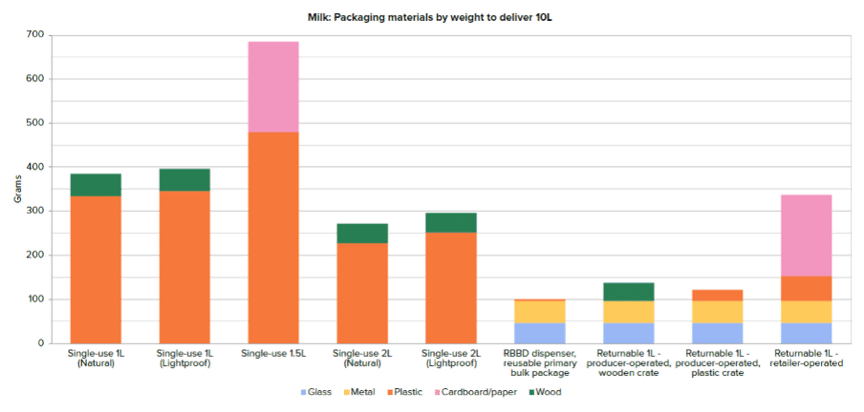In this edition
- Reuse in secondary and tertiary packaging
- Reusable packaging systems in the groceries sector
- Reusable packaging systems in animal agriculture
- Low-waste holiday toolkit
- Recent Reuse headlines
Reuse in secondary and tertiary packaging
Viscount may not be a name that many consumers are familiar with, but the organisation is an important part of the retail packaging sector! Viscount works in the secondary and tertiary packaging sector, providing reusable crates, bins and pallets to transport produce from growers to retailers. These reusable packaging assets protect the produce (both fragile produce and more robust), are stackable - enabling more efficient transport - and are significantly more sustainable than single use cartons.
This part of the sector is very important when supporting evaluation of single use vs reusable alternatives in terms of the amount of waste generated. Check out the next article for more info on evaluation.
Viscount has over 1 million assets in circulation, all sitting at various stages along the supply chain. The crates can last for roughly 10 years, which means each one can be used multiple times, eliminating a huge number of single use alternatives. At the end of their life, crates are recycled with the resin being incorporated into other products.
How does it all work? Once crates and bins have been used for transporting produce, they are returned for sorting, sanitisation and repair at one of three wash centres across Aotearoa, in Auckland, Palmerston North and Christchurch. After this they can then be distributed to growers for another cycle.
Find out more about Viscount and their reusable and returnable products here.
Reusable packaging systems in the groceries sector
A new report measuring the impacts and outcomes of reusable packaging systems for grocery items in Aotearoa was released in October.
The report, jointly authored by researchers from Reuse Aotearoa, Āmiomio Aotearoa, and the Bioeconomy Science Institute takes a wide approach to assessing reusable systems looking at impacts across accessibility, affordability, cultural appropriateness and public health.
Everyone needs groceries – that need is unavoidable. However, the grocery supply chain is very dependent on single-use packaging. To justify the investment in reusable systems the impact and benefit of them must be well understood.
The investigation looked at the 3 categories of reusable packaging systems:
- Returnable packaging - where producers fill their product into individual packaging units that they accept back when empty, recondition and refill again with the same product. These can be consumer-facing, such as reusable glass bottles for milk or the ABC Swappa Crate bottles, or they can be B2B, such as returnable jerry cans for cleaning products sold on tap, or stainless-steel kegs for on tap beverages.
- Refill by bulk dispenser/‘Unpackaged’ (bulk bins at supermarkets, fruit and vege)
- Reusable transport/transit packaging (CHEP, Loscam and Viscount reuse systems).
The study focused on two geographic areas (Waikato and Wellington) to compare six products in single-use packaging and reusable packaging. The six products chosen were: milk, oats, pumpkin seeds, olive oil, toothpaste and dishwashing liquid.
The study authors attempted to follow the products through their supply chains (from production or arrival in NZ, to the consumer) in their different packaging systems (single use and reusable) so that different impacts could be tracked. Information was obtained from publicly available data from retailers and suppliers/manufacturers websites to get the products’ prices and associated packaging information. The investigation also included interviews with retailers and suppliers/manufacturers, and site observations to gather data about packaging (where possible), jobs, food waste, and community/cultural concerns. There was an online and hard copy survey for customers at participating retailers, and the investigation also took into account other publicly available socio-economic data.
The study showed that reusable packaging systems almost always reduce packaging use, plastic use, and waste compared to single-use systems and sometimes by quite large margins. It is worth looking at all of the graphs in the report, but here is one example which focused on milk.

However, there’s an uneven playing field when it comes to price, because reusable packaging systems internalise their costs, whereas single use packaging externalise theirs. This means that in almost all cases, products in reusable packaging were more expensive. Most products in returnable, reusable packaging are also from smaller, independent and local retailers and suppliers/manufacturing. They can’t achieve economies of scale and are often not able to influence price setting behaviours of the supermarket duopoly. This means that they are generally more expensive and less accessible if you drive or rely on public transport for shopping.
This uneven playing field is significant. As at June 2025, half of the retailers operating reusable packaging systems that took part in this research have since closed.
A smaller retailer explains their challenging situation: “We would love to be a zero-waste store, but it’s hard and we need help. We need new legislation to require it so that we are on an even footing with other retailers (otherwise we just absorb the extra costs and things are already tight at the moment).”
Overall, the paper highlights how our urban infrastructures have co-developed with single-use packaging over the last roughly 50 years. For example, long supply chains, reliance on private cars for shopping, parking, and transport, and the expectation that councils will fund waste management. All of these things intersect to lock us into a linear economy and single-use packaging. Collective shifts are needed for transition. This won’t be solved by individual behaviour change.
Reusable packaging systems in animal agriculture
Another report, aiming to better understand current reusable packaging activity in the Waikato animal agricultural sector and the challenges and opportunities faced by the sector for establishing, sustaining, and scaling the uptake of reusable packaging was released in September.
The report focuses on packaging used on farms to contain products such as baleage, agrichemicals, fertiliser, veterinary products and animal feed.
The report authors undertook a desktop study to understand the fate of single-use packaging for on-farm products, and to scan for existing reusable packaging systems in the region’s agriculture sector. They also undertook interviews with individuals from across Waikato’s animal-based agricultural supply chain – including farmers, agricultural producers/suppliers, organisations that manage packaging logistics, and industry representatives – to understand attitudes to reusable packaging and the perceived barriers and opportunities to increasing these systems.
The research showed that there are some reusable packaging systems in Waikato’s animal agriculture sector, which shows that there is some interest in reusable systems in the sector. Examples included:
- Returnable packaging systems include plastic containers and drums for agrichemicals and oils that are collected back from farms, washed, and refilled (such as McFall Fuel’s returnable jerry cans for oil), or delivery of bulk quantities of product in returnable kegs that go back to the supplier once empty, replacing the need for small single-use bags (such as Dunstan Nutrition).
- Refill by bulk dispenser models include using silos for bulk products like fertiliser, where large quantities of a product like grain or fertiliser is delivered to farms and deposited on-farm without packaging, or where farmers drive their own form of transport to a silo to fill (such as Ballance Agri-Nutrients self-service silos).
The sector is also working towards a product stewardship scheme for certain on-farm plastics, with the Plasback scheme providing some reverse logistics for reuse systems – but this is limited and not well advertised.
Like in the grocery sector, there are a number of barriers to the roll-out and uptake of more reusable systems in the agricultural sector. Financial constraints continue to rank highly with farmers concerned they would have to shoulder the associated costs of reusable packaging systems, especially with the “3 Bs” (bury, burn or bulk storage of waste) providing the cheapest methods via on farm disposal. The product stewardship scheme roll-out does provide reuse opportunities, but with the focus squarely on recycling, it diverts attention from activities higher up the waste hierarchy. Other issues more unique to this sector include logistics and management, with many farms in remote areas and concerns about contamination and health and safety between types of products and across farms.
However, the report highlights that there are still several opportunities to increase the uptake of reuse systems, and goes on to make recommendations for future actions including:
- Councils supporting efforts to roll out reusable packaging schemes, through encouraging collaboration, work programmes, and funding streams.
- Development of standard protocols for reusable packaging system management and product design.
- Encouraging sector-led and industry leadership and support for reusable systems.

Reusable polypropylene (PP, #5) bags for fertiliser. Image from Ravensdown.
Low-waste holiday toolkit
The WasteMINZ Behaviour Change sector group has launched the low-waste holiday toolkit, full of simple content ideas, for newsletters, social media, and articles. Available for anyone to download and use here: Low waste holidays toolkit

Recent Reuse headlines
Find below some other reuse stories from around the globe that you may have missed:
Japan pushes reuse market as new consumption model
Bicycle reuse programmes report threefold return on investment
UK Packaging Pact drives refill and reuse systems as EPR fees take effect
Repurpose, reuse - less waste: Brits choosing to repair broken items rather than replace
Right to repair: Davidson apologises after missing bill speaking slot





